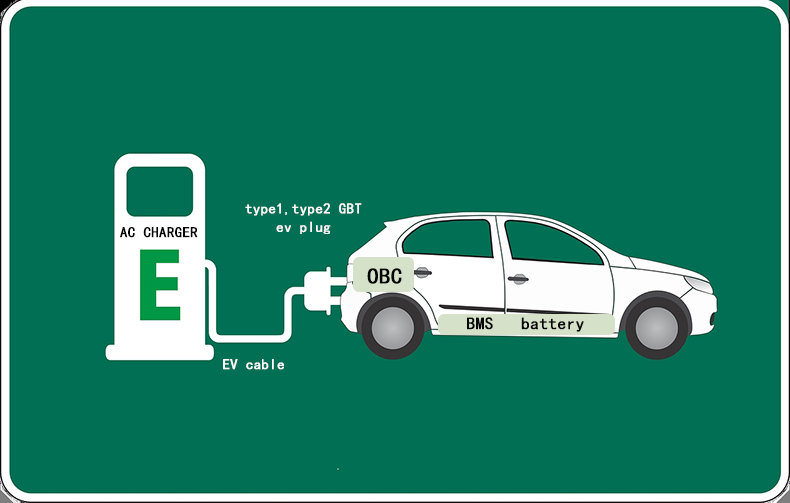How does the AC EV chargers work?
AC charging means that on-board charger(OBC) converts the alternating current into direct current to charge the power battery to complete basic AC charging. The components of AC charging mainly include power supply equipment, such as Portable EV charger or AC charging station, OBC, slow charging EV connetors, high-voltage control box, power battery, VCU, BMS, high-voltage wires, low-voltage wires, etc.
1. On-board charger: converts alternating current into direct current according to control instructions to charge the battery.
2.AC charging connectors: divided into type1, type2, GBT EV connectors
3.VCU: Monitors the status of the vehicle and issues control instructions to the on-board charger to make it work or stop working, control its operating current and voltage, etc. It is the control brain of vehicle charging.
Mode 2 charging : It is a charging cable with control box that connects the external power grid and the vehicle, and directly provides AC power to the vehicle charger. The function box on the cable can detect the status of the vehicle and the power grid, connect or disconnect the power supply to the vehicle, and has certain protection functions, such as leakage protection, overcurrent, overvoltage, etc.
Mode 3 charging: EV wall box or AC charging station,The component of the vehicle that connects to the external power grid and directly provides AC power to the on-board charger. It also has the function of detecting the status of the vehicle and the power grid, and connecting or disconnecting power supply to the vehicle.
Electrical principles of EV AC charging
There are three charging modes in AC charging, namely mode 1, mode 2 and mode 3 charging. According to current standard requirements and charging safety, the use of mode 1 is strictly prohibited.
Whether it is mode 2 or mode 3, the schematic diagram is basically the same, but the AC power supply method of the power grid is different. Taking a certain project as an example, briefly describe its control strategy. Its electrical schematic, detection and control meet the standard requirements. At the same time, in order to facilitate customer use, the control strategy and sequence of AC charging are as follows:
①The on board charger detects CC and CP signals, and determines the power supply capability of the power supply equipment based on the CP signal.
② When the vehicle is in sleep or parking state, feedback is sent to the VCU through the on-board charger, the instrument wakes up to display the connection status, and wakes up the VCU and BMS at the same time.
③The on board charger feeds back the charging harness status and power supply equipment information to the BMS. After getting the connection signal, the BMS sends the charging request signal, battery voltage, battery temperature and other status information to the vehicle controller VCU by the CAN bus.
④VCU issues charging instructions to BMS and OBC by monitoring the gear status, parking switch status, insulation value status, power battery status information, etc. when the charging conditions are met.
⑤After receiving the instruction, BMS and OBC close the internal relay through the control circuit, so that the power supply passes through the portable EV charger or AC charge station, stepped down and rectified by the OBC, and then passes through the power distribution box to charge the power battery.
⑥When it is detected that charging is complete,VUC sends a stop command to the on-board charger.
⑦The OBC stops working.
⑧Power battery disconnect relay.

Comments
Post a Comment